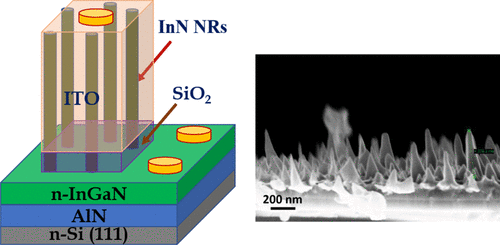当前位置:
X-MOL 学术
›
ACS Appl. Electron. Mater.
›
论文详情
Our official English website, www.x-mol.net, welcomes your
feedback! (Note: you will need to create a separate account there.)
Overcoming the Challenges Associated with the InN/InGaN Heterostructure via a Nanostructuring Approach for Broad Band Photodetection
ACS Applied Electronic Materials ( IF 4.3 ) Pub Date : 2021-09-15 , DOI: 10.1021/acsaelm.1c00695 Arun Malla Chowdhury 1, 2 , Deependra Kumar Singh 1 , Basanta Roul 1, 3 , K. K. Nanda 1 , S. B. Krupanidhi 1
ACS Applied Electronic Materials ( IF 4.3 ) Pub Date : 2021-09-15 , DOI: 10.1021/acsaelm.1c00695 Arun Malla Chowdhury 1, 2 , Deependra Kumar Singh 1 , Basanta Roul 1, 3 , K. K. Nanda 1 , S. B. Krupanidhi 1
Affiliation

|
One-dimensional nanostructures such as nanorods (NRs) and nanowires have garnered great interest, making them prospective candidates for the development of next-generation nanostructured devices. Herein, a self-powered, broad band, and ultrafast photodetector based on the n+-InN NRs/n-InGaN epilayer heterojunction has been demonstrated. The NRs and epilayer were grown on the AlN/n-Si(111) template by using plasma-assisted molecular beam epitaxy. The device exhibits an outstanding self-powered photodetection in the UV, visible, and infrared (IR) (300–1200 and 1550 nm) ranges with a maximum responsivity of 243.7 mA/W (675 nm). The response and recovery times have been estimated to be 358 and 103 μs, respectively. The maximum responsivity observed at 675 nm is believed to be due to the intermediate energy levels present in the forbidden gap of InGaN due to the nitrogen vacancies. The observed sublinear dependency of the photocurrent on the incident power density has been ascribed to the presence of interfacial inhomogeneities and defects. We believe that our findings would help in fabrication of high-quality optoelectronic devices as well as provide a deeper understanding of the transport properties of such NR-based heterojunctions.
中文翻译:

通过用于宽带光电检测的纳米结构方法克服与 InN/InGaN 异质结构相关的挑战
纳米棒(NRs)和纳米线等一维纳米结构引起了人们的极大兴趣,使它们成为开发下一代纳米结构器件的潜在候选者。在此,一种基于 n +的自供电宽带超快光电探测器-InN NRs/n-InGaN 外延层异质结已被证明。通过使用等离子体辅助分子束外延在 AlN/n-Si(111) 模板上生长 NRs 和外延层。该器件在紫外、可见光和红外 (IR)(300-1200 和 1550 nm)范围内表现出出色的自供电光电检测,最大响应率为 243.7 mA/W (675 nm)。响应时间和恢复时间估计分别为 358 和 103 微秒。在 675 nm 处观察到的最大响应率被认为是由于氮空位导致 InGaN 的禁带中存在中间能级。观察到的光电流对入射功率密度的亚线性依赖性归因于界面不均匀性和缺陷的存在。
更新日期:2021-09-28
中文翻译:

通过用于宽带光电检测的纳米结构方法克服与 InN/InGaN 异质结构相关的挑战
纳米棒(NRs)和纳米线等一维纳米结构引起了人们的极大兴趣,使它们成为开发下一代纳米结构器件的潜在候选者。在此,一种基于 n +的自供电宽带超快光电探测器-InN NRs/n-InGaN 外延层异质结已被证明。通过使用等离子体辅助分子束外延在 AlN/n-Si(111) 模板上生长 NRs 和外延层。该器件在紫外、可见光和红外 (IR)(300-1200 和 1550 nm)范围内表现出出色的自供电光电检测,最大响应率为 243.7 mA/W (675 nm)。响应时间和恢复时间估计分别为 358 和 103 微秒。在 675 nm 处观察到的最大响应率被认为是由于氮空位导致 InGaN 的禁带中存在中间能级。观察到的光电流对入射功率密度的亚线性依赖性归因于界面不均匀性和缺陷的存在。











































 京公网安备 11010802027423号
京公网安备 11010802027423号